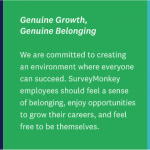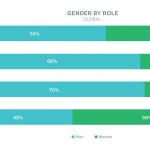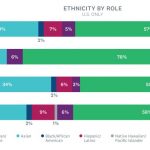At SurveyMonkey, we are committed to creating an environment where everyone, no matter their background, can succeed. That’s why we created a Diversity and Inclusion program that integrates into all parts of our business. In late 2016, when we began laying the foundation for our program, we had no idea the social and political climate that was to follow. Now more than ever our efforts around diversity and inclusion are critical, and we know that being transparent is an essential step to holding ourselves accountable.
As our CEO Zander Lurie says in his blog post, “We measure our demographics to understand where we have gaps and study our inclusion practices to further tear down barriers for our employees and the industry. By creating an environment that strives to eliminate bias, we can unlock the true potential of all groups to thrive.”
Below you’ll find our first ever Diversity Report, which includes our aspirations, goals, and progress. We hope our insights help to further the conversation and we encourage others to join this growing movement.
Aspirations
Our program has three main aspirations:

So, how are we doing?
In the last year, we’ve made great progress in our efforts to close the gender gap. Today, 45% of our overall global workforce is female, and in the last year, female representation in technical roles at SurveyMonkey grew by six percentage points to 30%. Similarly, the number of females in leadership roles grew by four percentage points to 32%.
We definitely have more work to do on the ethnic and racial diversity front. Currently, we are creating programs to help grow our numbers, which we explore below.
While we know there is room for improvement, we are proud to be moving in the right direction.
Today’s team

Note: As an example, a two “percentage point” increase in women overall represents a change from approximately 43% to 45%.


Next Steps
As leader of our Diversity and Inclusion program, I’ve been reflecting on our progress and contemplating our road ahead. We’re working on projects, policies, and partnerships that focus on building a diverse team and an inclusive environment.
- HBCU Partnership: When it comes to ethnic and racial diversity, we’ve taken steps to address the lack of growth we’ve seen by partnering with Historically Black Colleges and Universities (HBCUs). Our ultimate goal is to create a company where our workforce reflects the diversity of our customers. In working with HBCUs, we are able to connect with students interested in working at tech companies in Silicon Valley and engage them in our internship program.
- Inclusion and Belonging Survey: Many organizations are now publishing their internal demographic statistics. This is progress, yes, but numbers are only half the story when talking about diversity and inclusion. Equally important is creating an environment of inclusiveness in the workplace so all employees can thrive. At SurveyMonkey, we recently launched our Inclusion and Belonging Survey, which allows us to look under the surface and understand the level of inclusion employees feel across our offices. With this data, we will develop strategies to support employees. We plan to share our findings, strategies, and survey template in the future.
- Gender Pay Study: One of our aspirations is genuine growth, and this requires our employees are paid equitably for the work they do, regardless of gender or ethnicity. In 2017, we will engage in a formal gender and ethnicity pay study to ensure the analysis we’ve done internally is accurate and we commit to addressing any issues.
Want to build diversity and inclusion at your workplace?
Our end-to-end guide includes free templates and expert advice for building an inclusive company culture.
Definitions
- Tech roles include: Solutions Engineer, CS Infrastructure, Survey Research, Prod Marketing, Data Science, Product, Product (Growth), Engineering, User Exp Design, Quality Assurance, Tech Ops, IT, Prod Operations
- Underrepresented minorities include: Black/African American, Hispanic/Latino, American Indian/Alaskan Native, Native Hawaiian/Pacific Islander, and two or more races.
- Leadership: Includes VPs and higher roles.
- Gender metrics include all members of our team. Race/ethnicity metrics include only U.S. employees.



